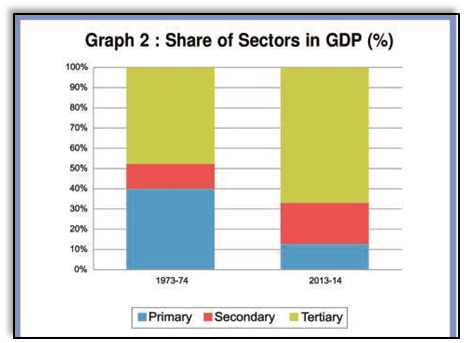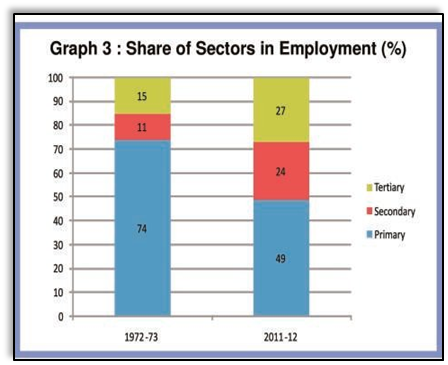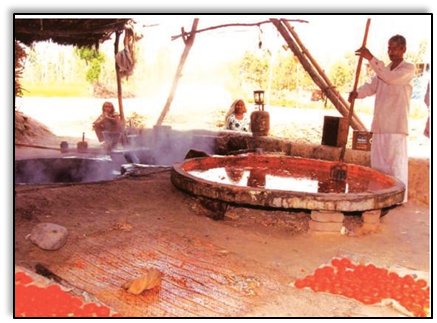- Books Name
- Understanding Economic Development Class-10
- Publication
- PathSet Publications
- Course
- CBSE Class 10
- Subject
- Economics
IMPORTANCE OF TERTIARY
- Over the last 40 years, production in all the three sectors has increased but the maximum increase was observed in the tertiary sector.
- As a result, in the year 2013-14, the tertiary sector has emerged as the largest producing sector in India replacing the primary sector. Let us look at the reasons behind the increase in the production of the tertiary sector.

- First, in any country, several services such as hospitals, educational institutions, post and telegraph services, police stations, courts, village administrative offices, municipal corporations, defense, transport, banks, insurance companies, etc. are required. These can be considered as basic services.
- Second, the development of agriculture and industry leads to the development of services like transport, banking, insurance etc.
- Third, as income levels rise, certain sections of people start demanding many more services like eating out, tourism, shopping, private hospitals, private schools, professional training etc.
- Fourth, over the past decade or so, certain new services such as those based on information and communication technology have become essential. The production of these services has been rising rapidly.
THE MOST EMPLOYMENT GIVING SECTOR
- Even though there had been an increase in the production in all three sectors, still, more than half of the population was employed in the primary sector producing only 1/6th of the GDP, because there are not enough job opportunities in the secondary and tertiary sector.
- There are more people in agriculture than is necessary. So, even if you move a few people out, production will not be affected. In other words, workers in the agricultural sector are underemployed.

- In this case, labor effort is divided and everyone works less than their potential.
- This kind of underemployment is hidden in contrast to someone who does not have a job and is visible as unemployed. Hence, it is also called disguised unemployment.
- If we remove many people from the agricultural sector and provide them with proper work elsewhere, agricultural production will not suffer. The incomes of the people who take up other work would increase the total family income.
- This underemployment can also happen in other sectors. For example, there are thousands of casual workers in the service sector in urban areas who search for daily employment. They are employed as plumbers, painters etc. They are doing this work because they do not have better opportunities.

- However, there are certain ways to create more employment. It can be done as:
- Putting unirrigated land on use by the development of irrigation facilities (for example, construction of wells, dams etc.), will enable more crops to be produced on land and better utilization of workers.
- If the government invests some money in transportation and storage of crops or makes better rural roads so that mini-trucks reach everywhere several farmers, who now have access to water, can continue to grow and sell these crops. This activity can provide productive employment to not just farmers but also others such as those in services like transport or trade.
- We also need to provide cheap agricultural credit to the farmers for farming to improve.
- Open cold storage. It can allow farmers to store their products like potatoes and onions and sell them when the price is good.
- In villages near forest areas, we can start honey collection centers where farmers can come and sell wild honey. It is also possible to set up industries that process vegetables and agricultural produce like potato, sweet potato, rice, wheat, tomato, fruits, which can be sold in outside markets. This will employ in industries located in semi-rural areas and not necessarily in large urban centers.
- A study conducted by the erstwhile Planning Commission (now known as NITI Aayog) estimates that nearly 20 lakh jobs could be created in the education sector alone. Similarly, if we are to improve the health situation, we need many more doctors, nurses, health workers etc. to work in rural areas.
- The central government in India made a law implementing the Right to Work in about 625 districts of India. It is called Mahatma Gandhi National Rural Employment Guarantee Act 2005 (MGNREGA 2005).

- Under MGNREGA 2005, all those who can, and need, work in rural areas are guaranteed 100 days of employment in a year by the government. If the government fails in its duty to provide employment, it will give unemployment allowances to the people. The types of work that would in the future help to increase the production from land will be given preference under the Act.

 PathSet Publications
PathSet Publications
